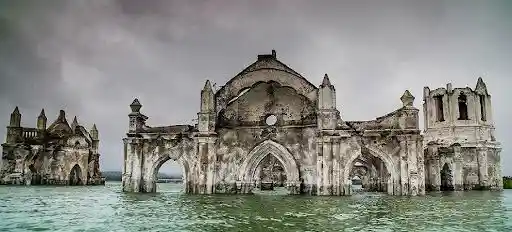Shettihalli, the sinking cathedral
There are many such ancient places in our world that still make us think that a secret is never hidden, whether it is a dark cave, a ruined fort, an old mansion, or a beautiful underwater church. All of these have a story buried inside them. This is the story of one such mysterious place, Shettihalli, also known as “the drowning church.”

Shettihalli, The drowning rosary church of India; Image source - Ixplore
India is associated with many mystical and ancient legends, one of them being the Shettihalli Church. When the water of the Hemavati River rises, the Shettihalli Church submerges in it, and when the water recedes, the ruins of the Shettihalli Church make a new beginning. This is what distinguishes Shettihalli as unique.
About 25 kilometres from Hassan in Karnataka is a small village called Shettihalli. It is located on the banks of the Gorur-Hemavathi reservoir. Shettihalli used to be a very successful agricultural village, noted for its sunflower fields, until the reservoir at Gorur was built. When the yellow flowers swayed in the winds, it made the place a sight to behold.
The Rosary Church, or Shettihalli Church, was built around 160 years ago by Europeans in Shettihalli village on the banks of the Hemavathi River. It is a long-forgotten reminder of the village's earlier days and a great example of Gothic design. It is claimed that "French missionary Abbe J. A. Dubois" constructed it. The materials used at the time were simple brick and mortar with Belgian stone, Egyptian gypsum, molasses, and eggshells. Despite all this, it managed to maintain its existence in the present time.
The church was built in India during the early days of the establishment of British rule to attract wealthy property owners. Along with the ancient walls, the tall pillars are also visible with a black and grey tint, rising even higher above the blue undulating waters.
The ruins are intriguing and some mysterious stories revolve around these gloomy and forgotten structures. There is one such intriguing and deserted church which is also known as "The Submerged Church" or "The Floating Church" in modern times.
It is thought that the Rosary Church provided shelter for the poor in 1873 during the famine. It was sometimes referred to as the "Arogyaswami Church" since it helped anyone in need regardless of their religious beliefs. Travelers are now enticed to see these ancient ruins because of their beauty.
Just 10 km from Holenarasipur is the village of Gorur, which came into the limelight in 1960 when a dam was built on the Hemavathi River. During the monsoon, when the water level of the dam reached its full capacity, the smiles on the faces of the farmers returned. After 100 years, in 1960, when the Gorur Dam was built on the Hemavathi River, the Rosary Church was shifted to a different location. But the old structure has been left there and it is now partially submerged during the monsoon and re-emerged in winter. The village is not just famous for the church but is also known as the birthplace of the famous Kannada writer, Goruru Ramaswamy Iyengar.
When the dam was built, 28 villages were submerged, and thousands of villagers had to flee. But the Shettihalli Rosary Church, then located in the area, still stands as a symbol of the devastation caused by the construction of the dam.
The fascinating thing about this church is that it is visible above the water in the months of December-May, and then one can walk around it to enjoy its structure. The whole scene changes in July-September, when the church is partially submerged in water, which is nothing less than a mystery.

The ruins of Shettihalli Rosary church, Image source- Lost with purpose


